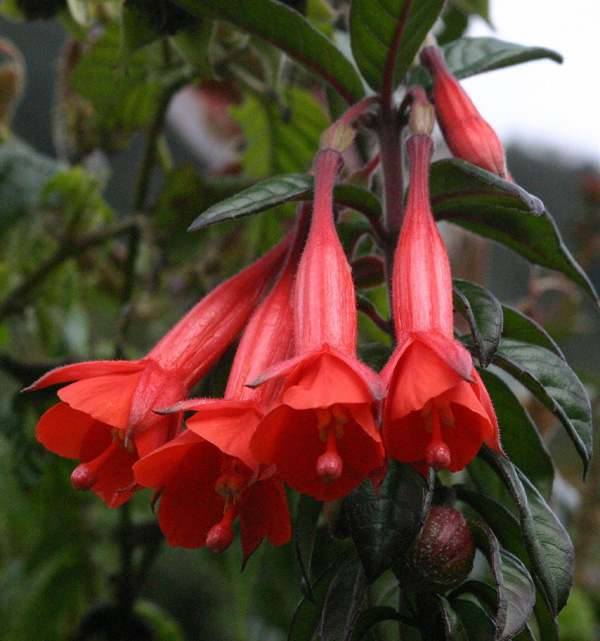speedy-seeds.co.uk
Fuchsia Vulcanica | "Lady's Eardrops" 20+ seeds | Stunning & Rare
Couldn't load pickup availability
Please find for sale 20+ seeds for a rare and stunning perennial, Fuchsia Vulcanica "Vulcans"
PLEASE NOTE: All orders received before 8pm (Mon-Fri) will be dispatched same day
SAVE PACKAGING MATERIALS - SEE OTHER INTERESTING & UNUSUAL SEEDS & PLANTS IN MY SHOP
INSTRUCTIONS - TO SAVE PAPER I NO LONGER SEND OUT WRITTEN INSTRUCTIONS TO CUSTOMERS. INSTRUCTIONS ARE BELOW SO PLEASE BOOKMARK THIS PAGE.
Native to the high forests of the Andes in south America, this beautiful and rare Fuchsia variety grows to around 1 meter tall with long, tubular, pinkish red and orange flowers followed by small, edible fruits. As it is from high altitudes in its native habitat, it is actually very east to grow in the UK where of of course our temperate climates meaning extremes of heart and cold are rare.
Growing Guide
Fuchsia Vulcans can be grown as hardy Fuchsias in the UK - i.e. they can be kept in the garden overwinter, but may need some protection to ensure they come through unscathed, particularly in cold regions and severe winters. Protect the roots and the crown by applying a thick mulch of bark, compost or even straw around the plants in autumn. Don’t cut down the stems until spring, when new growth begins. Hardy fuchsias growing in containers may be prone to frost damage even in reasonably mild winters, so protect the container to prevent the compost and roots freezing solid.
Germination
- Sow indoors in late winter / early spring
- Sprinkle seeds onto a well draining compost in seed tray
- Compost should ideally be a well draining 50/50 mix of regular compost and horticultural sand
- Cover seeds with a very fine layer or sieved compost
- Keep moist but not wet - best to water from the bottom by having seeds tray inside a waterproof container.
- Keep at 17-25 degrees during day and 10-15 degrees at night - so ideal place is on window sill over a radiator as long as heating goes off/down at night
- Thin seedlings and pot on as required.
TOP TIP! Don't use all your seeds in the same tray just in case rot sets in.
Olly's General Guide to Seed Sowing!
I love sowing seeds and it runs in the family - dad, granddad and finally my great-granddad for whom the hobby helped him get over his experiences in the Great War. I still get a big kick when I see the first seedling poking through from a new plant that I have never sown before or been successful at. However, even the most experienced gardeners draw "blanks" from time to time. Whilst I sow all the seeds that I sell so I know that they are viable, some are trickier than others and problems can arise so here are some tips to make "blanks" few and far between:
1) Don’t Rush! Tempting though it is when that packet arrives in the post to simply bung the seeds in some compost!
2) Google and YouTube are your friends! Take some time so see the methods other people use to germinate the seed.
3) Think Nature! What conditions do seeds face? For example a seed from a tropical plant will fall to the warm, wet and dark jungle floor. A seed from the mountains of Europe will fall to the floor in Autumn, then have to endure months of freezing temperatures before germinating in the spring. So as growers, what we are trying to do is to simulate the conditions that the seeds will naturally experience and there are plenty of tricks that can be done to short cut the processes somewhat.
4) Good compost pays dividends. The best investment you can make is to purchase three bags - one of potting compost, one of vermiculite and one of horticultural sand. With these three bags I can make up whatever soil type a particular seed likes (although for most seeds I find a 50/50 mix of compost and vermiculite works just fine)
5) Rot is your enemy. The single biggest danger to seed germination is rot - either before or after "damping off" the seeds germinate. To reduce the risk, ensure you have good free draining soil mix and that it is moist but not wet. Unless the seed variety absolutely requires it I prefer NOT to cover my seeds trays with plastic bags, Whilst germination is often faster this way, it greatly increases the risk of rot. I prefer to place my seed trans inside a watertight plastic tray and water from the bottom - airflow over the surface reduces the risk.
Materials
Materials
Shipping & Returns
Shipping & Returns
Dimensions
Dimensions
Care Instructions
Care Instructions


Image with text
Pair text with an image to focus on your chosen product, collection, or blog post. Add details on availability, style, or even provide a review.
-
Free Shipping
Pair text with an image to focus on your chosen product, collection, or blog post. Add details on availability, style, or even provide a review.
-
Hassle-Free Exchanges
Pair text with an image to focus on your chosen product, collection, or blog post. Add details on availability, style, or even provide a review.


